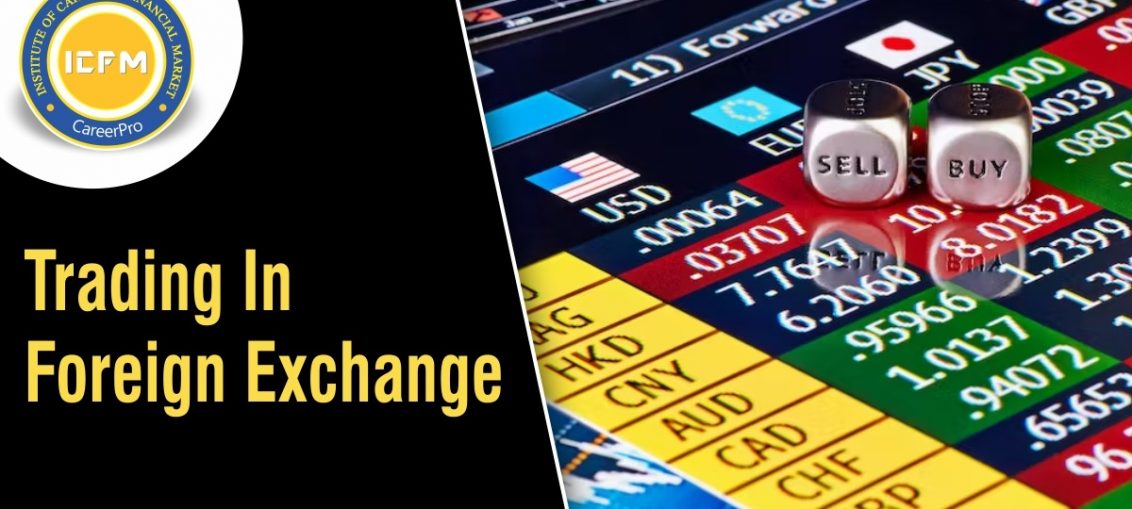
Trading In Foreign Exchange is the process of buying and selling currencies in the market with the sole motto of making a profit. It became popular over the year as people are showing interest in knowing and learning about forex trade with the aim of making profits and potentially earning a living from it.
In this blog, we will get to know about the basics and general overview of forex trading, which is required to become a budding forex trader.
-
BASICS OF Trading In Foreign Exchange
- In forex trading, we deal in currencies.
- The Forex market is the Biggest financial market in the world.
- Daily average trading of $6.6 trillion.
- This market is open 24/7, it is best for traders who want to trade at any time.
- Trading in currencies is always done in pairs. For example, EUR/USD, AUD/JPY, etc.
- In EUR/USD- QUOTE CURRENCY is USD this price changes, BASE CURRENCY is EUR this remains 1 unit.
- The aim of forex trading is to sell at high and buy at low depending on the strategies that the trader follows.
-
FACTORS THAT AFFECT FOREX TRADING
- Economic data such as GDP, inflation, and employment data can have a significant impact on currency prices. Central bank decisions, such as interest rate decisions, can also affect currency prices.
- Geopolitical events affect the forex market. For example, a country’s political instability can cause its currency to depreciate.
- Technical analysis is another factor that can affect forex trading. Technical analysis involves using charts and indicators to analyze past price movements and predict future price movements.
-
IMPACT OF NEWS OR FLAGS
There is a significant impact of news on the forex market.
NEWS is of three types-
- RED- It creates a high impact on currency prices. This price can deviate from 50-100 pips up or down. For example – a country becomes unstable currency falls sharply or the country shows good economic growth which will lead to rising in the currency.
- GREEN- It creates a mid-impact on the currency. The price can deviate from 20-30 or 10-15 pips up or down. For example – if the employment rate of the country is positive then there is a positive movement of 20-30 or 10-15 pips, if the employment rate is negative then the movement is vice versa.
- YELLOW- It creates a low impact or negligible impact on the currency. The price deviates by 1-5 pips up or down. For example, – The housing data report, indicates the health of the housing market it has a low impact on the currency market.
-
FOREX TRADING STRATEGIES
There are multiple trading strategies in forex trading. One of the most popular strategies is TREND FOLLOWING (use of intraday trader).
- One must find the Support price and resistance of desired currency pair.
- If the market touches the resistance price trader starts selling as there is a chance that it can go down from there.
- If the market breaks the resistance price then the trader starts buying, as this indicates a change in market sentiments.
- If the market touches the support price then the trader starts buying as there is a huge chance of the market going up.
- If the market breaks the support price then traders start short-selling, as market sentiment changes.
There is another strategy called the Swing trading strategy
- Here the trader is sought as a mid-term trader.
- They hold positions for several days aiming to make a profit from price fluctuation.
- Although it’s quite risky, as the risk of gapping is there.
- Analyses of the trend for several days are done by traders who opt for swing trading.
-
MORE VOLATILE CURRENCY PAIRS
CURRENCY VOLATILITY is measured by calculating the variance of price movements of the currency.
The lower the volatility lower the risk and the profit margin is also set accordingly, but the higher the volatility higher the risk, and the profit margin also increases.
Some of my favorites are –
- AUD/USD
- CAD/JPY
- USD/JAR
- AUD/JPY
- NZD/JPY
- RISK MANAGEMENT
It is the most important aspect of forex trading. It involves significant risk, and management of risk to avoid huge losses is key to becoming a successful forex trader.
- STOP LOSS ORDER – A trader must set a stop loss order to limit losses incurred. It is an order to end trade when the price hits a specific value on the loss side.
- Leverage management is necessary to avoid significant losses. Holding of larger position with a small amount of capital is leverage. However, the risk of losses increases as we use leverage.
- CONCLUSION
Forex trading is exciting and holds the potential to be a profitable activity. However, it also involves significant risk, and traders must be disciplined and knowledgeable to succeed. To become a successful forex trader, you need to learn the basics of forex trading, develop a trading strategy, and manage your risk effectively. With the right mindset and approach, forex trading can be a lucrative career or a source.
Tags: Share Market Institute, Stock Market Course, indian stock market course, Share Market Classes